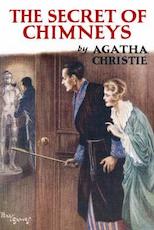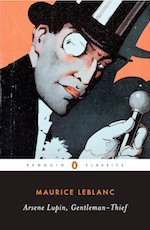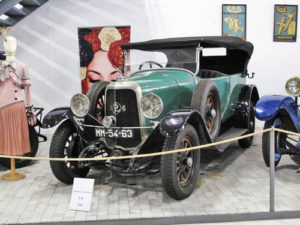
Poirot Score: 60
The Secret of Chimneys
☆☆☆
Reasons for the Poirot Score
This is an enjoyable read with many fair clues. It is a rather bewildering first read as there are fifteen main characters and three professional detectives. There are also jewel thieves, blackmailers and two sets of murderers. Some loose ends are never tied. However, it is so full of sub-plots and humour that the novel can be re-read many times. It is therefore the highest scoring of Christie’s early thrillers, but it is also something of a country house murder mystery too.
Click here for full review (spoilers ahead)
Trivia
Dedication
To my nephew in memory of an inscription at Compton Castle and a day at the Zoo
The book is dedicated to Christie’s nephew, Jack, who was born in 1903. Miss Madge Miller, Christie’s older sister, married James Watts in 1902 when Agatha was 12 years old. Agatha and Jack were close: more an older sister/younger brother fun relationship than Victorian aunt and nephew. It was through Jack that Christie met her second husband, Max Mallowan, a young archaeologist who was asked to show her around the dig. Max had been at Oxford with Jack. Max Mallowan married Agatha Christie in 1930, when he was 26 years old and she was 39.
Fast Cars
https://www.carandclassic.co.uk/car/C822393
Bundle drove a slightly earlier model. Lady Eileen Brent is a thoroughly modern girl: independent of thought and action. She enjoys driving, although few of the characters volunteer to be her passengers for a second time. Very few young women could drive in 1924, unless they’d been in the War. We never learn what was Lady Brent’s war work: she may have been too young.
Cubism
Anthony Cade says, when he finds the sign of the Comrades of the Red Hand:
It looks like a hand, but if you say so, I’m quite prepared to admit that it’s a Cubist picture of Sunset at the North Pole.
This is another book {see The Man in the Brown Suit trivia} with Cubist references. Quite how Anthony Cade knows about Cubism when he’s been in the African bush, and presumably not close to any French Art Galleries, for years is never explained. Perhaps, after all, it’s a tribute to his Eton and Oxford education.
Women In Politics
Reading books written nearly 100 years ago makes you realise just how things have changed. George Lomax says ‘
Not that I approve of women in politics….But a woman in her own sphere can do wonders’.
This book was written six years after women could, for the first time in Britian, be elected as Members of Parliament. Women in politics was bitingly new and threatening to someone like George Lomax. Bundle (Lady Eileen Brent) would not have been able to vote: women received the vote on the same terms as men (over the age of 21) as a result of the 1928 Representation of People Act.
Bundle has no time for George Lomax:
‘George was always an ass – he must know that servants know everything.’
Foreigners
There are plenty of remarks about ‘Foreigners’ in this novel.
“‘Another Dago’ thought Anthony”. This is surprising as he himself is Herzoslovakian. Is this a subtle misdirection by Christie, or simply the product of being an Eton and Oxford Man in the early part of the 20th Century? The word ‘Dago’ a rather shockingly disparaging term is used several times. It reflects the spoken vocabulary used in the 1920s.
‘I thought she would go into hysterics – she’s French, you know’ {the reason for concealing the murdered body from her French maid}
‘Pure-bred Herzoslovakian…Most uncivilized people. A race of brigands.’ {the explanation of the revenge for Prince Michael’s murder}.
The real Koh-i-Noor
The Koh-I-Noor, mountain of light, diamond was once the largest diamond in the world. It was in the possession of many rulers in India from the 13th century. It was seized by the British East India Company in 1850 and given to Queen Victoria, to enter the British Crown Jewels. Prince Albert was dissatisfied with its cut and got it re-cut to add brilliance, but lost 42% of the diamond in the process! India, and other countries and groups, have asked for its return, but at present it remains in the Tower of London.
Altered names in the book
The Blitz Hotel, London, is clearly a nod to the Ritz Hotel. (Tommy and Tuppence visit the The Ritz Hotel http://www.theritzlondon.com in The Secret Adversary)
Harridge’s Hotel, London also appears in this book, which I suspect is inspired by the real Claridge’s Hotel: http://www.claridges.co.uk.
Doctors’ inability to precisely state the time of death
‘doctors aren’t such magicians that they can tell you exactly how many hours a man has been dead. The exact time of his death will be pretty vague.’
I was pleased to read this. Although a doctor myself, I have no idea from an examination alone how long a person has been dead for. TV dramas, such as CSI, and detective novels including some by Agatha Christie, have given the general public an unshakable belief that all doctors can date the time of death accurately. It is strange that Christie writes this statement in this book, and then promulgates the myth in other novels!
Detectives
Battle says to Cade ‘I’d like you to work in with me over this case. The amateur and the professional, they go well together. The one has the intimacy..the other the experience’.
“‘Never display emotion’ That was a rule given to me once, and I’ve found it very useful’ {Battle}
‘Detective stories are mostly bunkum,’ said Battle, ‘they encourage the universal idea that the police are stupid. When we get an amateur crime, such as a murder, that’s very useful indeed’.
Arsène Lupin
 Bill mentions ‘this Arsène Lupin fellow’ meaning King Victor. Arsène Lupin was a French fictional gentleman jewel thief , rather in the style of Raffles. The books were very popular in France and England written by Maurice Leblanc {11 November 1864 – 6 November 1941}. The first Arsène Lupin short story was published in 1905. As a child Agatha Miller (Christie) and her parents spent several years in France, after her father lost his fortune, since it was cheaper for them to rent out their grand house in Torquay, and live abroad on the rental income. Agatha was fluent in French, so may have read Leblanc in French or English. There is a really fun museum in Leblanc’s house at Étretat, Normandy.
Bill mentions ‘this Arsène Lupin fellow’ meaning King Victor. Arsène Lupin was a French fictional gentleman jewel thief , rather in the style of Raffles. The books were very popular in France and England written by Maurice Leblanc {11 November 1864 – 6 November 1941}. The first Arsène Lupin short story was published in 1905. As a child Agatha Miller (Christie) and her parents spent several years in France, after her father lost his fortune, since it was cheaper for them to rent out their grand house in Torquay, and live abroad on the rental income. Agatha was fluent in French, so may have read Leblanc in French or English. There is a really fun museum in Leblanc’s house at Étretat, Normandy.
Class
‘the majority of people are always wondering what the neighbours will think. But tramps and aristocrats don’t – they just do the first thing that comes into their heads, and they don’t bother to think what anyone thinks of them. …..I’ve always found the upper classes the same – fearless, truthful, and sometimes extraordinarily foolish.’ {Battle}
‘governesses and companions and people one sits opposite to in trains. Its awful, but I never really look at them properly’ . This is said by Virginia of ‘servants’.The idea that someone like a murderer can disguise themselves as a butler/waiter/maid and no-one of any importance looks at them is found also in Sir Arthur Conan Doyle’s first Holmes novel, A Study in Scarlet.
La Sûreté
The former title of the French National Police was La Sûreté Nationale.
The Sûreté was founded in 1812 by Eugène François Vidocq, who headed it until 1827. It was the inspiration for Scotland Yard and the FBI.
Vidocq was convinced that crime could not be controlled by the then-current police methods, so he organized a special branch of the criminal division modelled on Napoleon’s political police. The force was to work undercover and its early members consisted largely of reformed criminals. By 1820 – eight years after its formation – it had blossomed into a 30-man team of experts that had reduced the crime rate in Paris by 40%.
The Sûreté is considered a pioneer of all crime fighting organizations in the world.


